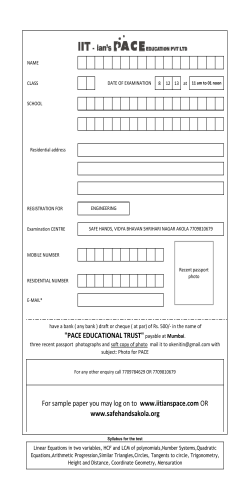
What are bryophytes?
Tommy Prestø, Michael Lüth and Kristian Hassel NTNU Vitenskapsmuseet naturhistorisk notat 2014-10 Bryophytes of the Longyearbyen area NTNU Vitenskapsmuseet naturhistorisk notat 2014-10 Tommy Prestø, Michael Lüth and Kristian Hassel Bryophytes of the Longyearbyen area NTNU Vitenskapsmuseet naturhistorisk notat Dette er en elektronisk serie fra 2013 som erstatter tidligere Botanisk notat og Zoologisk notat. Serien er ikke periodisk, og antall nummer varierer per år. Notatserien benyttes til rapportering fra mindre prosjekter og utredninger, datadokumentasjon, statusrapporter, samt annet materiale som ikke har en endelig bearbeidelse. Tidligere utgivelser: http://www.ntnu.no/vitenskapsmuseet/publikasjoner Referanse Prestø, T., Lüth, M. & Hassel, K. 2014. Bryophytes of the Longyearbyen area – NTNU Vitenskapsmuseet naturhistorisk notat 2014-10: 1-68. Trondheim, november 2014 Utgiver NTNU Vitenskapsmuseet Seksjon for naturhistorie 7491 Trondheim Telefon: 73 59 22 60/73 59 22 80 e-post: [email protected] Ansvarlig signatur Torkild Bakken (seksjonsleder) Publiseringstype Digitalt dokument (pdf) Forsidefoto Bryum cryophilum rosevrangmose, Isdammen (Kristian Hassel) www.ntnu.no/vitenskapsmuseet ISBN 978-82-7126-997-5 ISSN 1894-0064 2 Summary Prestø, T., Lüth, M. & Hassel, K. 2014. Bryophytes of the Longyearbyen area – NTNU Vitenskapsmuseet naturhistorisk notat 2014-10: 1-68. Bryophytes constitute an important component of Arctic ecosystems both in relation to species diversity and biomass production. This is an introduction to these small but beautiful plants in the Longyearbyen area. What is a bryophyte and how can we recognize them? Are bryophytes really important for us? In what habitats can we find bryophytes? These are some of the questions we try to answer in this presentation. In addition we have collected photographs of some of the common, rare or particular beautiful species of bryophytes that can be found in the Longyearbyen area. Key words: bryophytes - mosses – liverworts – hepatics - Svalbard – Arctic Tommy Prestø & Kristian Hassel, NTNU University Museum, NO-7491 Trondheim Michael Lüth, Umweltplanung, Emmendinger Str. 32, D-79106 Freiburg, Germany 3 Contents Summary ...........................................................................................................................................3 Preface ..............................................................................................................................................5 Introduction ........................................................................................................................................6 What are bryophytes? .......................................................................................................................6 The historical exploration of Svalbard bryophytes ............................................................................7 The importance of bryophytes on Svalbard and in the Arctic ...........................................................7 Why are there so many bryophyte species on Svalbard? ................................................................8 Threats to bryophyte diversity in the Longyearbyen area.................................................................8 How to determine and collect bryophytes? .......................................................................................8 Why collect and document in herbaria? ..........................................................................................12 Some bryophyte habitats in the Longyearbyen area ......................................................................13 Species presentations .....................................................................................................................22 Bryophyta - mosses ................................................................................................................... 22 Sphagnales Limpr. ............................................................................................................. 22 Andreaeales Limpr. ........................................................................................................... 25 Polytrichales M.Fleisch. ..................................................................................................... 26 Dicranales H. Philib. ex M. Fleisch. ................................................................................... 29 Pottiales M. Fleisch. .......................................................................................................... 34 Grimmiales M. Fleisch. ...................................................................................................... 36 Timmiales (M. Fleisch.) Ochyra ......................................................................................... 38 Encalyptales Dixon ............................................................................................................ 39 Funariales M. Fleisch. ....................................................................................................... 40 Splachnales (M. Fleisch.) Ochyra ..................................................................................... 40 Bryales Limpr. .................................................................................................................... 47 Orthotrichales Dixon .......................................................................................................... 52 Hypnales (M. Fleisch.) W. R. Buck & Vitt .......................................................................... 53 Marchantiophyta – liverworts..................................................................................................... 62 Jungermanniales Klinggr. .................................................................................................. 62 Metzgeriales Chalaud ........................................................................................................ 66 Marchantiales Limpr. ......................................................................................................... 66 References ......................................................................................................................................68 Useful floras ............................................................................................................................... 68 4 Preface In 2013 the Annual excursion of the Nordic Bryological Society took place on Svalbard July 22nd to 28th of July. The main aims of these excursions are exploration of areas where the bryophyte flora is not very well known and sharing of bryophyte knowledge and experience among the participants. The participants paid most of the costs themselves but financial support granted by the Svalbard Environmental Protection Fund and SABIMA made it possible to lower the personal costs and to reach other destinations than Adventdalen. We are grateful to the participants for joining the excursion and contributing with their expertise: Gordon Rothero (UK), David Long (UK), Niklas Lönnell (SWE), Torbjørn Høitomt (NOR), Michael Lüth (GER), Tomas Hallingbäck (SWE), Irina Goldberg (DEN), Eigil Plöger (DEN), Gerhard Kristensson (SWE), Leif Appelgren (NOR), Tom Blockeel (UK), Kåre A. Lye (NOR), Heinjo During (NED) and Dinie During (NED). Special thanks to our patient polar bear guard Iva Hlaváčková. Trondheim, november 2014 Kristian Hassel Tommy Prestø 5 Introduction Svalbard is still a fairyland to many of us. But due to favorable climatic conditions, compared with other Arctic regions, the plant life is rather diverse. The vascular plants of Svalbard are well recognized, especially those with colored flowers. But this leaflet is dedicated to the more species rich group of bryophytes. Presentation of the species focuses on some of the larger species that are easy to find, important ecological species, species of specialized habitats and species that are interesting in a broader view. A high number of bryophytes are found in the Longyearbyen area. The area has favorable climatic conditions compared to many other parts of Svalbard. The habitat types are many due to large variation in topography, exposure, geology etc. For a long time the availability of the area for scientists has been better than most other parts of Svalbard. Nevertheless, much of the knowledge is 40-100 years old. Most records are inaccurate as they were not located with detailed maps or GPS. Longyearbyen is located at the island Spitsbergen, which is the largest island of the Svalbard archipelago. Longyearbyen is at 78°N and 15°E, while Svalbard stretches from 74° to 81°N and 10° to 30°E. The total area of Svalbard is 62 160 km2 of which about 60% is covered by glaciers. The climate of Longyearbyen is Arctic with a mean of -15.2°C in the coldest month (February) and a mean of 6.2°C in the warmest month (July). Mean annual precipitation at the Longyearbyen airport is 190 mm. Three bioclimatic zones are recognized at Svalbard: Arctic polar desert, northern Arctic tundra and middle Arctic tundra. Longyearbyen area is situated in the middle Arctic tundra zone. The bedrock of the Longyearbyen area is dominated by Cretaceous and Tertiary sandstones, which make up the bedrock on both sides of Adventfjorden. This is base rich bedrocks that erodes easily and make minerals available for plant growth. What are bryophytes? Bryophytes are small, green plants without flowers and seeds. The term bryophyte is a collective term used for three evolutionary independent plant groups: mosses, liverworts (also called hepatics) and hornworts. The first two are found on Svalbard. Together, the vascular plants and the bryophytes is what we call land plants. The green bryophyte shoot is the gametophyte, most often consisting of stem with leaves, but some liverworts have creeping thallus. The sporophyte does not have leaves. It is short-lived, attached to the gametophyte and often the color differs from the rest of the plant. Bryophytes are primary producers, they photosynthesize and make green tissue like flowering plants by converting energy from the sun to chemical energy. The chemical energy is released to growth, reproduction and other activities in the bryophyte plant. Bryophytes reproduce sexually by spores. The spores are produced in a capsule on top of the sporophyte. Most species have tiny spores adapted to wind dispersal. Asexual reproduction takes place by fragmentation of the green gametophyte. Some species also produce specialized propagules like gemmae in the leaf axils or easily detached leafs. More than 380 bryophyte species are recorded from Svalbard. Among these are about 40 species not known from mainland Norway. This is a rather large number as there are about 1 080 species in Norway, 1 600 in Europe and 15 000 – 20 000 species in the World. The bryophyte species diversity on Svalbard is high also compared to the ca. 175 species of vascular plants. Taxonomically the bryophytes of Svalbard belong to two phyla and 137 genera. These phyla are as little related as are a grass, a spruce tree and a tulip. The term liverwort comes from the “Doctrine of Signature” as the liver-shaped outline of some species was thought to be useful in treating diseases of the liver. 6 The historical exploration of Svalbard bryophytes The first scientific report of bryophytes from Svalbard was made by Phips in 1773, most likely from Amsterdamøya. Major contributions were made by the Swedes Lindberg (1867) and Berggren (1875). Lindberg never collected on Svalbard himself but published a list of 158 species based on specimens collected by Norwegian and Swedish scientific expeditions. Berggren collected in many parts of Svalbard in 1868 and published a list of 226 species. Important contributions of more recent dates include Russian, Polish and Norwegian scientists, including the bryologists in Trondheim. By 2014 herbarium TRH at NTNU University Museum have 17 093 bryophytes in 8 793 collections from Svalbard. The major contributor is Arne A. Frisvoll (9 404). Both Frisvoll and Kjell Ivar Flatberg have described new bryophyte species to science based on collections made on Svalbard the last decades. Specimen information is published in Species Map Survice – Artskart and in Global Biodiversity Facility (GBIF): http://www.artsdatabanken.no/ http://www.gbif.org/ The importance of bryophytes on Svalbard and in the Arctic “Moss tundra” is a term suggesting that mosses and other bryophytes are important. But what are their ecological roles in the Arctic? In Arctic and alpine ecosystems the bryophytes are important both regarding the species diversity and biomass production. The further north or higher altitude you go to, the more bryophyte diversity and dominance increases relative to vascular plants. Bryophytes absorb water and nutrients all over their surface. They don’t have roots or proper vascular tissue for internal transportation. Most bryophytes can survive long or short periods of drought and resume growth when water again is available. This is why so many bryophytes can grow on periodically dry substrates like rocks and cliffs. In Arctic ecosystems the annual net production of bryophytes sometimes exceeds production of vascular plants. As with vascular plants the bryophyte production is highest in wet meadows, grass heath and dwarf shrub vegetation, were water is not a strong limiting factor for growth. However, the major contribution in terms of bryophyte biomass production is in peat lands, including Arctic mire ecosystems. Here bryophytes, peat mosses Sphagnum in particular, play a very important role in relation to global carbon balance. In moss tundra the bryophyte cover may be 100 %. In wet grasslands the bryophyte cover may be 98 %, forming an almost complete cover on the ground below the grasses and sedges. Bryophytes, especially mosses may act as facilitators for vascular plants during early successional stages of barren land. They conserve soil moisture and reduce soil temperature fluctuations. Bryophyte mats can act as seed beds for seedlings of vascular plants. Bryophytes are also habitats for numerous microorganisms. The Svalbard reindeer eats more bryophyte (mosses) than other reindeer in the world. Late winter diet may contain up to 32-39 % mosses! It is suggested that the Svalbard reindeer has intestines better adapted to consume foods of extremely low digestibility than other reindeer and thereby being able to exploit nutritious parts of the bryophytes. In particular the bryophytes may be important as a mineral nutrient source, e.g. calcium for mammal skeletons. 7 Why are there so many bryophyte species on Svalbard? Svalbard archipelago shows despite its northerly position high heterogeneity in climate and topography. This is the main reason for the high variation in plant communities at the islands. Many pioneer bryophytes are weak competitors for space and light and my find many potential places to grow in the open Arctic vegetation. This is also true for bryophyte species that are generalists and can be found in many habitats. However, quite large portion of the species may be characterized as specialists and grows in one or a few habitats. A large variation of available habitats is probably the main factor contributing to the species diversity. But other factors like the bryophytes high dispersal capacity of tiny spores and high desiccation tolerance are also important. Part of the explanation may also be due to polar refugia, areas in the Arctic that were not covered by ice during the last glaciation. Part of Prins Karls Forland is a possible biological refugium. Bryophyte spores and shoot fragments of some species can survive under ice for a very long time. A 1500 year old moss found in the permafrost on Signy Island, Antarctica was brought back to life. At 35 m below the present surface of Longyearbreen 1600 years old bryophytes were found. Given the right conditions such pieces can start to grow again! Threats to bryophyte diversity in the Longyearbyen area With today’s limited knowledge of the bryophyte flora of Svalbard and Longyearbyen area it is difficult evaluate past and future development of the bryophyte species at Svalbard. For some of the species there are few records i.e. less than five from the whole archipelago, and these may be termed rare. Some of these rare species may be naturally rare due to their highly specialized habitat requirements and thus not really threatened. However, if some of these species are sensitive to a changing climate, higher geese populations or their habitat decrease due to construction work of roads, houses, mines etc. they should be viewed as threatened. Conflicts between management of the Longyearbyen settlement and biodiversity in the Longyearbyen planning area may involve threats to bryophytes, as may also the in general increasing pressure on natural resources. However, in areas with low direct human influence at the ecosystems, changes of climatic conditions, fluctuating populations of ecosystem key species, diseases and stochastic events may be the most important treats to bryophyte populations. Some of the rare bryophyte species on Svalbard may be relict populations from warmer postglacial periods. They often have few and small populations in areas with favorable climatic conditions. In the Longyearbyen area, sites with favorable conditions are found in south-exposed meadows and heaths and relatively warm mires, cliffs and bird cliffs. Other rare species are found among the high-arctic bryophytes, those which are really adapted to extreme conditions. Many of these belong to the ca. 40 species not known from mainland Norway, and Svalbard has a special responsibility to secure healthy populations of these species. How to determine and collect bryophytes? If you start looking at bryophytes you will soon see that there are differences in colors, sizes, shoot and leaf shapes, growth forms and what habitats they occupy. Here are some things you can start with when looking at bryophytes: Habitat – describe the nature type at the place of growth, dry or wet, grassland, mire, bird cliff, stony ground, etc. 8 Growth form – Do they grow in cushions, mats, tufts, wefts or a single shoots? Are the shoots creeping to the ground or standing upright? Substrate – Does it grow on soil, humus, rock, sand, etc. Single shoot anatomy – Is the shoot branched or not? What’s the color? Can you see any special structures on leaves, stems or sporophytes? A) Unbranched shoots, B) dichotomous branching, C) dendroid or treelike branching, D) regularly pinnately branched, E) bipinnately branched and F) irregularly branched (redrawn after Fältbiologerna 1995). Leaf arrangement – Do all leaves look the same? Are leaves lined up in rows? A) leaves spirally arranged around the stem, B) leaves spirally arranged, but shoot complanate, C) leaves in two rows, and a liverwort (to the right) with a third row of amphigastria on the ventral side, D) leaves appressed to stem, E) leaves spreading and F) leaves squarrosely spreading (redrawn after Fältbiologerna 1995). 9 Leaf characters – What’s the leaf shape? Are the leaf margins toothed or plain? Is there a nerve in the leaf? A) leaf with hairpoint, B) leaf with a sheating basal part, C) leaf with a defined margin, D) incurved leaf margin, E) recurved leaf margin, F) leaf wit an entire margin, G) leaf margin with simple teeth, H) leaf margin with double teeth, I) leaf without costa, J) leaf with short double costa, K) leaf with a single costa that reach the leaf apex and L) undulated leaf (redrawn after Fältbiologerna 1995). 10 Sporophytes and capsules – What’s the shape of the capsules? Round, oblong, asymmetrical, striped, smooth, etc. What’s the color of the stem? Gemmae – Do you see any gemmae in the end of the shoots or other parts? Acrocarp (A & B) and pleurocarp (C & D) - of practical reasons the mosses are divided in two growth-form groups: The acrocarps grow upright and the sporophytes are found on top of the plants. The pleurocarps form horizontal mats and sporophytes are usually formed along the main stem (redrawn after Fältbiologerna 1995). 11 Leafy and thallose - the liverworts also can be divided in: leafy species with normal stems and leaves and thallose liverworts which do not have stems or leaves but an undifferentiated body. These groupings are helpful when determining bryophytes. The thallose Preissia quadrata to the left and the leafy Douinia ovata to the right (redrawn after Schofield 1985) Equipment needed – paper bags for samples, hand-lens for study (×10-20), map/GPS for location data and something for write with. Do not use plastic bags. For more detailed studies forceps and a stereo microscope is an advantage. Preparation of samples – bryophytes can be air-dried. Do not dry them in an oven. Pressing them flat is unnecessary. Why collect and document in herbaria? Herbaria are found at the University Museums. One of their main purposes is to document the Norwegian biological diversity. A picture may serve as plain documentation of an observation of a species, but a museum object can be re-examined to check identification. The museum object can be used for many other purposes in research. Documentation by collecting is important as the identity of many bryophytes is difficult to establish. Try to collect typical specimens when collecting. If possible make rich collections, avoid single shoots. Look an extra time for shoots with sporophytes and capsules. 12 Some bryophyte habitats in the Longyearbyen area Main habitats in the area are: ridges, snow-beds, heaths, wetlands, shore-meadows, bird-cliffs, polar deserts, screes and cliffs, sandy and gravelly sites, moraines and block fields. A very few species are omnipresent – they occur in a wide variety of habitats. Three such species are Ceratodon purpureus, Sanionia uncinata and the liverwort Blepharostoma trichophylla. Ridge vegetation is found in mounds and ridges that rise above the surrounding terrain. On the exposed ridges with a thin snow cover bryophytes occur scattered. Typical species are desiccation tolerant species like Bryum argenteum, Dicranum laevidens, Distichium spp., Ditrichum flexicaule, Encalypta spp., Racomitrium panschii, Stegonia latifolia and liverworts like Gymnomitrion spp. and Lophozia spp. In the more sheltered parts of the ridges dominated by Dryas octopetala and Cassiope tetragona mosses like Aulacomnium turgidum, Dicranum majus, Dicranum spadiceum, Hylocomium splendens, Hypnum bambergeri, Hypnum revolutum, Pohlia cruda and Tomentypnum nitens and liverworts like Barbilophozia lycopodoides, Ptilidium ciliare and Tritomaria quinquedentata are common. Rare bryophytes are found in Cassiope tetragonavegetation in climatic favorable areas in Longyeardalen, Endalen, Todalen, Bolterdalen and Bjørndalen. Cassiope tetragona-heath. Svalbard, Longyeardalen. Photo TP. In heath vegetation of open plains with moderate snow cover Saxifraga oppositifolia, Salix polaris and Luzula confusa are dominating vascular plants. These heaths are moist or wet in the first half of the growing season but drying of in the second half. Heath covers large areas in the lower parts of the hills and flat parts of the valleys. Bryophyte and lichen species are numerous and abundant. A very common species in heaths is Sanionia uncinata, others are Hylocomium splendens, Polytrichastrum alpinum, Polytrichum juniperinum and Racomitrium canescens, and in wet parts also Scorpidium revolvens and Tomentypnum nitens. One of the most exclusive species in Salix polaris-heath is Voitia hyperborea. 13 Snow-bed vegetation is found in depressions where snow accumulates. They melt out late and growth season is short. Bryophytes are common in all snow-beds. Typical bryophytes of “mossy snow-beds” are Anthelia juratzkana, Kiaeria glacialis, Polytrichastrum alpinum, Sarmentypnum sarmentosum, Marsupella arctica and the omnipresent Blepharostoma trichophylla and Sanionia uncinata. Measured in biomass the contribution of liverworts is relatively higher in snow-beds than most other vegetation types. In Oxyria digyna-dominated snow-beds typical bryophytes are Bryum spp., Distichium spp., Ditrichum flexicaule and Orthothecium chryseon. In the wetter Deschampsia alpinasnow beds Calliergon giganteum, Campylium stellatum, Catoscopium nigritum, Cinclidium arcticum, Meesia triquetra, Philonotis tomentella, Pseudocalliergon lycopodioides, Pseudocalliergon turgescens and Scorpidium revolvens are typical species, some of which are even more common in wetlands. Snow-bed. Svalbard, Burmavegen. Photo TP. Wetland vegetation types on Svalbard are moss tundras, damp grasslands and Artic mires. The bryophytes, particularly the mosses, make up a thick, colorful and dominant layer on top of the permafrost. Wetlands have seeping water, often with much nutrients and they stay wet all growing season because bryophytes have a prominent insulation effect. Typically the permafrost is about 30 cm below the surface. Moss tundra occurs in lower hillsides and valley bottoms. They are dependent on seeping, fresh water during the growing season and snow-cover is moderate and stable during winter. Dominant species often include Aulacomnium palustre, Bryum cryophilum, Dicranum angustum, Straminergon stramineum and Tomentypnum nitens, but moss tundras often include small populations of many moss and liverwort species. 14 Moss tundra. Svalbard, Linnévatnet. Photo TP. Moss tundra with Bryum cryophilum NO Rosevrangmose. Svalbard, Isdammen. Photo ML. The damp grasslands occur in places with abundant supply of water. Access to oxygen is lower than in other wetlands as water may stand still or move very slowly part of the summer. Bryophytes tolerating such conditions are Calliergon giganteum, Meesia triquetra, Pseudocalliergon turgescens, Sarmentypnum sarmentosum, Scorpidium cossonii, Scorpidium revolvens, Scorpidium scorpioides, etc. 15 Damp grassland. Svalbard, Adventdalen. Photo TP. Arctic mires are moist or wet vegetation where large amounts of humus or peat from the bryophytes accumulate. Dead bryophytes are deposited in water and peat is formed because deficit of oxygen prevent them from decaying. Bryophytes insulate the mire system and permafrost prevents further decay. As a consequence the mires grow in height. A main difference between Arctic mires and other mire types is the fact that permafrost literally freezes the transformation and decomposition of the plants. Peat mosses are not common on Svalbard but they occur in Arctic mires in the Longyearbyen area and some places in large quantities. The most common of the 11 species are Sphagnum girgensohnii, Sphagnum squarrosum and Sphagnum warnstorfii. Four more scattered species Sphagnum arcticum, Sphagnum concinnum, Sphagnum olafii and Sphagnum tundrae were all described as new species to science based on material from Isfjorden, three of them based on plants from the Longyearbyen area. Recent studies have shown that they occur in other Arctic regions as well but they are not found in mainland Europe. This is one of the most exclusive elements in the flora of Svalbard. Other important species in mires are Bryum spp., Cinclidium spp., Loeskypnum badium, Meesia spp., Oncophorus wahlenbergii, Paludella squarrosa, and the liverwort genera Lophozia spp. and Scapania spp. Many rare bryophytes occur in small populations in mires and especially rich fens. Some mosses grow almost exclusively on dung of reindeer on Svalbard. 16 Arctic mire with several species of peat mosses Sphagnum spp. Svalbard, Longyeardalen. Photo TP. Peat mosses Sphagnum spp. mixing in cushions in wetlands. Svalbard, Bjørndalen. Photo TP. 17 Rich fen. Svalbard, Isdammen. Photo TP. Rich fen with Paludella squarrosa. NO Piperensermose. Svalbard, Kapp Linné. Photo TP. Sphagnum olafii is named after Prof. Olaf I. Rønning, Trondheim, the first to publish a list of peat mosses on Svalbard and one of the “Godfathers” of UNIS Shore-meadow vegetation is a bad habitat for bryophytes. Few species occur as tolerance to salt water is low to most bryophytes. Wetland species and those from brook and river edges occasionally occur close to the sea. 18 Shore-meadow with Carex ursina and Puccinellia phyganodes. Svalbard, Adventdalen. Photo TP. Bird cliff vegetation is found in steep slopes and on cliffs with high availability to mineral nutrients, phosphorous and nitrogen in particular. Bird cliffs are often very rich in species and vegetation is often well-developed with a mixture of vascular plants, bryophytes and lichens. Species of Orthotrichum spp. and Schistidium spp. are often abundant in bird cliffs. Timmia spp. often occur by the base of bird cliffs. Polar deserts have very scattered plant cover due to thin or no snow cover and high desiccation all year. Bryophytes are found on sand and gravel between rocks, e.g. Arctoa anderssonii and Conostomum tetragonum, and species of Andreaea, Pogonatum, Polytrichum, Racomitrium, Schistidium spp. and liverworts Cephalozia spp., Marsupella spp. In the Longyearbyen area polar deserts are found mainly on the mountain plateaus. The peat mosses of the tundra are the sponges of the Arctic. They can absorb 20 times as much water as their own dry weigth. 19 Polar desert with Andreaea sparsifolia. Svalbard, Breinosa. Photo ML. Screes in steep slopes are made up of sand, gravel and stones. In this unstable habitat we find colonists like Didymodon asperifolius, Hypnum revolutum, Racomitrium canescens, Schistidium grandirete, Syntrichia ruralis, etc. Moss-dominated, stabilized scree with rocks and gravel. Svalbard, Platåberget. Photo TP. Brooks and rivers are often sandy, gravelly or rocky habitats. Disturbed river banks and are important for small bryophytes with low ability to compete with larger vascular plants. Brook margins are typical Rhizomnium andrewsianum, Plagiomnium curvatulum, Bryum spp., whereas Hygrohypnum spp. grow on rocks in brooks and rivers and Pogonatum dentatum, Psilopilum cavifolium and small liverworts of genus Scapania and genus Lophozia grow on wet soil by the brooks. 20 Brook with bryophytes on rocks, Hygrohypnum cochlearifolium NO Skeibekkemose. Svalbard, Platåberget. Photo ML. The moss family Splachnaceae is especially interesting. In Svalbard the species of this family grow mainly on dung, and dung from reindeer is particularly common. Dung in wet habitats is more attractive than dry dung and the most common species are Splachnum vasculosum, Tetraplodon pallidus and Tetraplodon paradoxus. Other species on dung in the Longyearbyen area are Splachnum sphaericum, Tetraplodon blyttii and Voitia hyperborea. Dung is a concentrated spot with nitrogen and phosphorous and in Arctic regions decomposition is rather slow, so dung may be an attractive habitat for specialized bryophytes for many years. Even old, humidified dung may be important, for instance for Voitia hyperborea. Reindeer dung in Dryas octopetala-Cassiope tetragona-heath with Splachnum sphaericum NO Blankmøkkmose. Svalbard, Longyeardalen. Photo ML. 21 Species presentations The following section presents some of the species you might come across in the Longyearbyen area. We aim at presenting a taste of the variation in the bryophyte flora with both common and rare species. The order of species is taxonomically so closely related species are found in the vicinity of each other. This is a subset of the ca. 300 bryophyte species found in the Longyearbyen area, so to conduct reliable identification of species you find, you have to consult floras that treat larger parts of the Svalbard bryophyte flora (list of floras is found after the species presentations). Bryophyta - mosses Sphagnales Limpr. Sphagnaceae Dumort. Sphagnum squarrosum. NO Spriketorvmose. Greenland, Zackenberg. Photo KH. 22 Sphagnaceae continued Sphagnum aongstroemii. NO Fjelltorvmose. Svalbard, Longyeardalen. Photo ML. Sphagnum arcticum. NO Polartorvmose. Svalbard, Longyeardalen. Photo ML. 23 Sphagnaceae continued Sphagnum concinnum. NO Istorvmose. Svalbard, Longyeardalen. Photo ML. Sphagnum olafii. NO Frosttorvmose. Greenland, Zackenberg. Photo KH. 24 Andreaeales Limpr. Andreaeaceae Dumort. Andreaea obovata. NO Felesotmose. Svalbard, Adventdalen. Photo ML. Andreaea sparsifolia (syn. Andreaea rupestris var. sparsifolia). NO Bergsotmose. Svalbard, Bjørndalen. Photo ML. 25 Polytrichales M.Fleisch. Polytrichaceae Schwägr. Polytrichum hyperboreum. NO Aurbjørnemose. Svalbard, Longyeardalen, Photo KH. Polytrichastrum alpinum. NO Fjellbinnemose. Svalbard, Longyeardalen. Photo ML. 26 Polytrichaceae continued Polytrichum jensenii. NO Strandbjørnemose. Svalbard, Breinosa. Photo ML. Polytrichum piliferum. NO Rabbebjørnemose. Norway, Kongsvoll. Photo TP. 27 Polytrichaceae continued Psilopilum cavifolium. NO Småkomagmose. Svalbard, Adventdalen. Photo ML. Psilopilum laevigatum. NO Storkomagmose. Greenland, Zackenberg. Photo TP. 28 Dicranales H. Philib. ex M. Fleisch. Dicranaceae Schimp. Dicranum spadiceum. NO Rørsigd. Svalbard, Bjørndalen. Photo Gordon Rothero. Dicranum groenlandicum. NO Putesigd. Svalbard, Longyeardalen. Photo ML. 29 Dicranaceae continued Dicranum elongatum. NO Såtesigd. Norway, Kongsvoll. Photo TP. Dicranum laevidens. NO Polarsigd. Svalbard, Longyeardalen. Photo ML. 30 Ditrichaceae Limpr. Distichium capillaceum. NO Puteplanmose. Svalbard, Longyeardalen. Photo KH. Distichium hagenii. NO Polarplanmose. Svalbard, Bjørndalen. Photo ML. 31 Rhabdoweisiaceae Limpr. Arctoa anderssonii. NO Svøpjøkelmose. Svalbard, Breinosa. Photo KH. Cnestrum glaucescens. NO Tundramyggmose. Svalbard, Longyeardalen. Photo ML. 32 Rhabdoweisiaceae continued Dicranoweisia crispula. NO Krusputemose. Norway, Furuhaugli. Photo KH. Oncophorus wahlenbergii. NO Fjellsprikemose. Svalbard, Breinosa. Photo Gordon Rothero. 33 Pottiales M. Fleisch. Pottiaceae Schimp. Hennediella heimii. NO Fjæremose. Svalbard, Adventdalen. Photo ML. Syntrichia ruralis. NO Putehårstjerne. Greenland, Zackenberg. Photo KH. 34 Pottiaceae continued Tortula leucostoma. NO Krølltustmose. Svalbard, Diabasodden. Photo ML. Tortula mucronifolia. NO Torntustmose. Svalbard, Longyeardalen. Photo ML. 35 Grimmiales M. Fleisch. Grimmiaceae Arn. Racomitrium canescens. NO Sandgråmose. Svalbard, Adventdalen. Photo ML. Racomitrium panschii. NO Tundragråmose. Svalbard, Longyeardalen. Photo ML. 36 Grimmiaceae continued Schistidium frisvollianum. NO Vorteblomstermose. Svalbard, Adventdalen. Photo ML. Schistidium grandirete. NO Polarblomstermose. Svalbard, Platåberget. Photo TP. 37 Timmiales (M. Fleisch.) Ochyra Timmiaceae Schimp. Timmia austriaca. NO Rødsliremose. Svalbard, Longyeardalen. Photo KH. Timmia bavarica. NO Grottesliremose. Svalbard, Diabasodden. Photo ML. 38 Timmiaceae continued Timmia norvegica. NO Vortesliremose. Svalbard, Adventdalen. Photo KH. Encalyptales Dixon Encalyptaceae Schimp. Encalypta alpina NO Fjellklokkemose. Svalbard, Diabasodden. Photo KH. 39 Funariales M. Fleisch. Funariaceae Schwägr. Funaria arctica. NO Polarbråtemose. Greenland, Zackenberg. Photo KH. Splachnales (M. Fleisch.) Ochyra Bartramiaceae Schwägr. Bartramia ithyphylla. NO Stivkulemose. Greenland, Nuuk. Photo TP. 40 Bartramiaceae continued Conostomum tetragonum. NO Hjelmmose. Svalbard, Longyeardalen. Photo ML. Meesiaceae Schimp. Leptobryum pyriforme. NO Pæremose. Svalbard, Bjørndalen. Photo KH. 41 Meesiaceae continued Meesia triquetra. NO Skruesvanemose. Svalbard, Adventdalen. Photo ML. Paludella squarrosa. NO Piperensermose. Svalbard, Isdammen. Photo ML. 42 Splachnaceae Grev. & Arn. Aplodon wormskioldii. NO Kadavermose. Svalbard, Bjørndalen. Photo KH. Splachnum sphaericum. NO Blankmøkkmose. Svalbard, Bjørndalen. Photo Gordon Rothero. 43 Splachnaceae continued Splachnum vasculosum. NO Knappmøkkmose. Svalbard, Adventdalen. Photo ML. Tetraplodon mnioides. NO Fagerlemenmose. Norway, Kongsvoll. Photo TP. 44 Splachnaceae continued Tetraplodon pallidus. NO Gull-lemenmose. Svalbard, Adventdalen. Photo ML. Tetraplodon paradoxus. NO Blindlemenmose. Svalbard, Bjørndalen. Photo KH. 45 Splachnaceae continued Voitia hyperborea. NO Snabelmose. Svalbard, Diabasodden. Photo KH. 46 Bryales Limpr. Aulacomniaceae Schimp. Aulacomnium palustre. NO Myrfiltmose. Norway, Kongsvoll. Photo TP. Aulacomnium turgidum. NO Fjellfiltmose. Svalbard, Longyeardalen. Photo KH. 47 Bryaceae Schwägr. Bryum cryophilum. NO Rosevrangmose. Svalbard, Isdammen. Photo ML. Cinclidiaceae Kindb. Cinclidium arcticum. NO Fjellgittermose. Svalbard, Adventdalen. Photo ML. 48 Cinclidiaceae continued Cinclidium latifolium. NO Fagergittermose. Svalbard,, Isdammen. Photo KH. Cinclidium subrotundum. NO Rundgittermose. Svalbard, Adventdalen. Photo ML. 49 Cinclidiaceae continued Cyrtomnium hymenophyllum. NO Tuetrollmose. Svalbard. Longyeardalen. Photo ML. Rhizomnium andrewsianum. NO Polarrundmose. Svalbard, Bolternosa. Photo TP. 50 Mielichhoferiaceae Schimp. Mielichhoferia elongata. NO Kopperkismose. Svalbard, Bjørndalen. Photo KH. Pohlia ludwigii. NO Fjellnikke. Svalbard, Breinosa. Photo ML. 51 Plagiomniaceae T.J.Kop. Plagiomnium curvatulum. NO Fjellfagermose. Svalbard, Isdammen. Photo ML. Orthotrichales Dixon Orthotrichaceae Arn. Orthotrichum sordidum. NO Hultannbustehette. Svalbard, Diabasodden. Photo ML. 52 Hypnales (M. Fleisch.) W. R. Buck & Vitt Amblystegiaceae G. Roth Campylium laxifolium. NO Kildestjernemose. Svalbard, Adventdalen. Photo ML. Campylium longicuspis. NO Polarstjernemose. Svalbard, Longyearbyen. Photo ML. 53 Amblystegiaceae continued Hygrohypnum cochlearifolium. NO Skeibekkemose. Svalbard, Platåberget. Photo ML. Hygrohypnum polare. NO Jøkelbekkemose. Svalbard, Platåberget. Photo ML. 54 Amblystegiaceae continued Pseudocalliergon trifarium. NO Navargulmose. Greenland, Kobbefjord. Photo TP. Sanionia georgicouncinata. NO Fjellbleikmose. Svalbard, Longyeardalen. Photo ML. 55 Amblystegiaceae continued Sanionia orthothecioides. NO Storbleikmose. Svalbard, Adventdalen. Photo ML. Sanionia uncinata. NO Klobleikmose. Svalbard, Bjørndalen. Photo KH. 56 Amblystegiaceae continued Tomentypnum nitens. NO Gullmose. Svalbard, Bjørndalen. Photo KH. Calliergonaceae (Kanda) Vanderp., Hedenäs, C. J. Cox & A. J. Shaw Calliergon richardsonii. NO Sumptjernmose. Svalbard, Adventdalen, Photo ML. 57 Calliergonaceae continued Loeskypnum badium. NO Messingmose. Svalbard, Adventdalen. Photo ML. Climaciaceae Kindb. Climacium dendroides. NO Palmemose. Norway, Kongsvoll, Photo TP. 58 Hylocomiaceae (Broth.) M. Fleisch. Hylocomium splendens. NO Etasjemose. Svalbard, Longyeardalen. Photo KH. Hypnaceae Schimp. Hypnum vaucheri. NO Gullflette. Svalbard, Longyeardalen, Photo ML. 59 Leskeaceae Schimp. Pseudoleskeella catenulata. NO Stumptråklemose, Svalbard, Diabasodden. Photo ML. Plagiotheciaceae (Broth.) M. Fleisch. Orthothecium chryseon. NO Gullhøstmose. Svalbard, Isdammen. Photo ML. 60 Pterigynandraceae Schimp. Pterigynandrum filiforme. NO Reipmose. Norway, Kongsvoll. Photo TP. Thuidiaceae Schimp. Abietinella abietina. NO Granmose. Svalbard, Adventdalen. Photo ML. 61 Marchantiophyta – liverworts Jungermanniales Klinggr. Antheliaceae R.M.Schust. Anthelia juratzkana. NO Krypsnømose. Norway, Kongsvoll, Photo TP. Cephaloziaceae Mig. Pleurocladula albescens. NO Bremose. Norway, Sulitjelma. Photo KH. 62 Gymnomitriaceae H. Klinggr. Marsupella arctica. NO Polarhutremose. Svalbard, Breinosa. Photo KH. Prasanthus suecicus. NO Rabbemose. Svalbard, Adventdalen. Photo ML. 63 Lophoziaceae Cavers Barbilophozia lycopodioides. NO Gåsefotskjeggmose. Norway, Kongsvoll. Photo TP. Leiocolea heterocolpos. NO Piskflik. Svalbard, Longyeardalen. Photo ML. 64 Pseudolepicoleaceae Fulford & J. Taylor Blepharostoma trichophyllum. NO Piggtrådmose. Svalbard Longyeardalen. Photo KH. Ptilidiaceae H.Klinggr. Ptilidium ciliare. NO Bakkefrynse. Greenland, Kobbefjord. Photo KH. 65 Metzgeriales Chalaud Aneuraceae Klinggr. Aneura pinguis. NO Fettmose. Greenland, Zackenberg. Photo KH. Marchantiales Limpr. Marchantiaceae (Bisch.) Lindl. Marchantia polymorpha ssp. montivagans. NO Fjelltvare. Svalbard, Ny Ålesund. Photo TP. 66 Marchantiaceae continued Preissia quadrata. NO Skjøtmose. Norway, Beiarn. Photo KH. List of photographers ML – Michael Lüth. KH – Kristian Hassel. TP – Tommy Prestø. 67 References Crawford, R.M.M. 2013. Tundra-taiga biology. Human, plant, and animal survival in the Arctic. Oxford University Press, Oxford. Daniels, F.J.A, Gillespie, L.J., Poulin, M., Afonina, O.M., Alsos, I.G., Aronsson, M., Bültmann, H., IckertBond, S., Konstantinova, N.A., Lovejoy, C., Väre H. & Westergaard, K.B.2013. Plants. Pp. 311-353 in Meltofte, H. (ed.) Arctic Biodiversity Assessment. Status and trends in Arctic biodiversity. Conservation of Arctic Flora and Fauna (CAFF), Akureyri. Frisvoll, A.A. & Elvebakk, A. 1996. Part 2. Bryophytes. Pp. 57-172 in Elvebakk, A. & Prestrud, P. (eds.): A catalogue of Svalbard plants, fungi, algae and cyanobacteria. – Norsk Polarinstitutt Skrifter 198. http://hdl.handle.net/11250/173512 Hagen, D. & Prestø, T. 2007. Biologisk mangfold – temarapport som grunnlag for arealplan for Longyearbyen planområde. – NINA Rapport 252. Hassel, K., Blom, H.H., Flatberg, K.I., Økland, R.H. & Johnsen, J.I. 2010. Red List of Anthocerophyta, Marchantiophyta, Bryophyta. Pp. 139-153 in: Kålås, J.A., Henriksen, S., Skjelseth, S. & Viken, Å. (eds.). 2010 Norwegian Red List. Norwegian Biodiversity Information Centre, Norway. pp. 139–153. Hassel, K., Prestø, T, & Schmidt, N.M. 2012. Bryophyte diversity in high and low arctic Greenland. Scientific Report from DCE – Danish Centre for Environment and Energy No. 27. Humlum, O., Elberling, B., Hormes, A., Fjordheim, K., Hansen, O.H. & Heinemeier, J. 2004. Late-Holocene glacier growth in Svalbard, documented by subglacial relict vegetation and living soil microbes. – The Holocene 15: 396-407. Longton, R.E. 1988. The biology of polar bryophytes and lichens. Cambridge University Press. Oskin, B. 2014. 1,500-year-old Antarctic moss brought back to life. http://www.livescience.com/44134-oldfrozen-antarctic-moss-regrows.html Rønning, O.I. 1996. The flora of Svalbard. Polarhåndbok 10. Norsk polarinstitutt, Oslo. Shaw, A.J. & Goffinet, B. (eds.) 2000. Bryophyte biology. Cambridge University Press. Useful floras Atherton, I, Bosanquet, S. & Lawley, M. (eds.) 2010. Mosses and Liverworts of Britain and Ireland – a field guide. British Bryological Society, Plymouth. Bergenståhl, B. et al. 1989. Fältbiologernas mossflora. Fältbiologerna, Sollentuna. Damsholt, K. 2002. Illustrated Flora of Nordic Liverworts and Hornworts. Nordic Bryological Society, Lund. Damsholt, K. 2013. The Liverworts of Greenland. Nordic Bryological Society, Lund. Flatberg, K.I. 2013. Norges torvmoser. Akademika, Trondheim. Hallingbäck, T. & Holmåsen, I. 1985. Mossor. En fälthandbok. Interpublishing, Stockholm. Hallingbäck, T., Lönnell, N., Weibull, H. & Hedenäs, L. 2006. Nationalnyckeln till Sveriges flora och fauna. Bladmossor: Sköldmossor-blåmossor. Bryophyta: Buxbaumia-Leucobryum. ArtDatabanken, SLU, Uppsala. Hallingbäck, T., Lönnell, N. & Weibull, H. 2008. Nationalnyckeln till Sveriges flora och fauna. Bladmossor: Kompaktmossor-kapmossor. Bryophyta: Anoectangium-Orthodontium. ArtDatabanken, SLU, Uppsala. Hedenäs, L. & Hallingbäck, T. 2014. Nationalnyckeln till Sveriges flora och fauna. Bladmossor: Skirmossorbaronmossor. Bryophyta: Hookeria-Anomodon. ArtDatabanken, SLU, Uppsala. Prestø, T. 1995. Moser i skog, systematikk og økologi : for kurset landskapsøkologi og biologisk mangfold ved Høgskolen i Nord-Trøndelag. – NTNU Vitenskapsmuseet, Botanisk notat 1995-4. http://ntnu.divaportal.org/smash/get/diva2:283298/FULLTEXT01.pdf 68 NTNU Vitenskapsmuseet er en enhet ved Norges teknisknaturvitenskapelige universitet, NTNU. NTNU Vitenskapsmuseet skal utvikle og formidle kunnskap om natur og kultur, samt sikre, bevare og gjøre de vitenskapelige samlingene tilgjengelige for forskning, forvaltning og formidling. Seksjon for naturhistorie driver forskning innenfor biogeografi, biosystematikk og økologi med vekt på bevaringsbiologi. Seksjonen påtar seg forsknings- og utredningsoppgaver innen miljøproblematikk for ulike offentlige myndigheter innen stat, fylker, fylkeskommuner, kommuner og fra private bedrifter. Dette kan være forskningsoppgaver innen våre fagfelt, konsekvensutredninger ved planlagte naturinngrep, for- og etterundersøkelser ved naturinngrep, fauna- og florakartlegging, biologisk overvåking og oppgaver innen biologisk mangfold. ISBN 978-82-7126-997-5 ISSN 1894-0064 © NTNU Vitenskapsmuseet Publikasjonen kan siteres fritt med kildeangivelse www.ntnu.no/vitenskapsmuseet
© Copyright 2025









